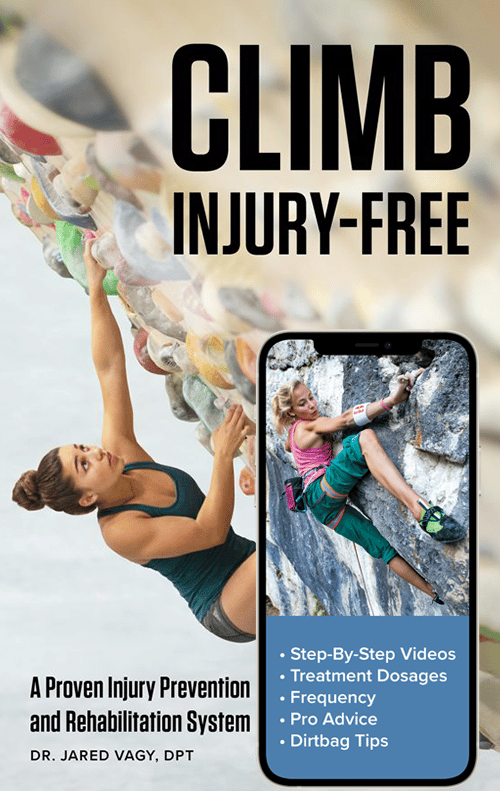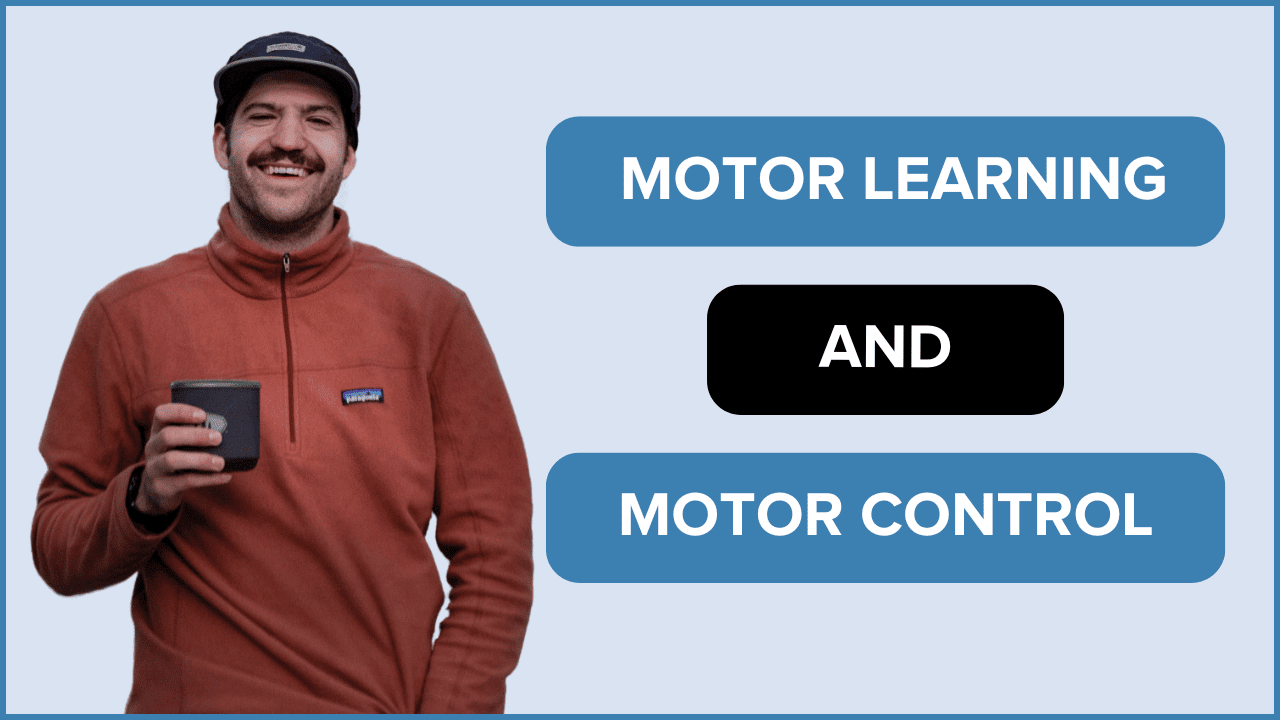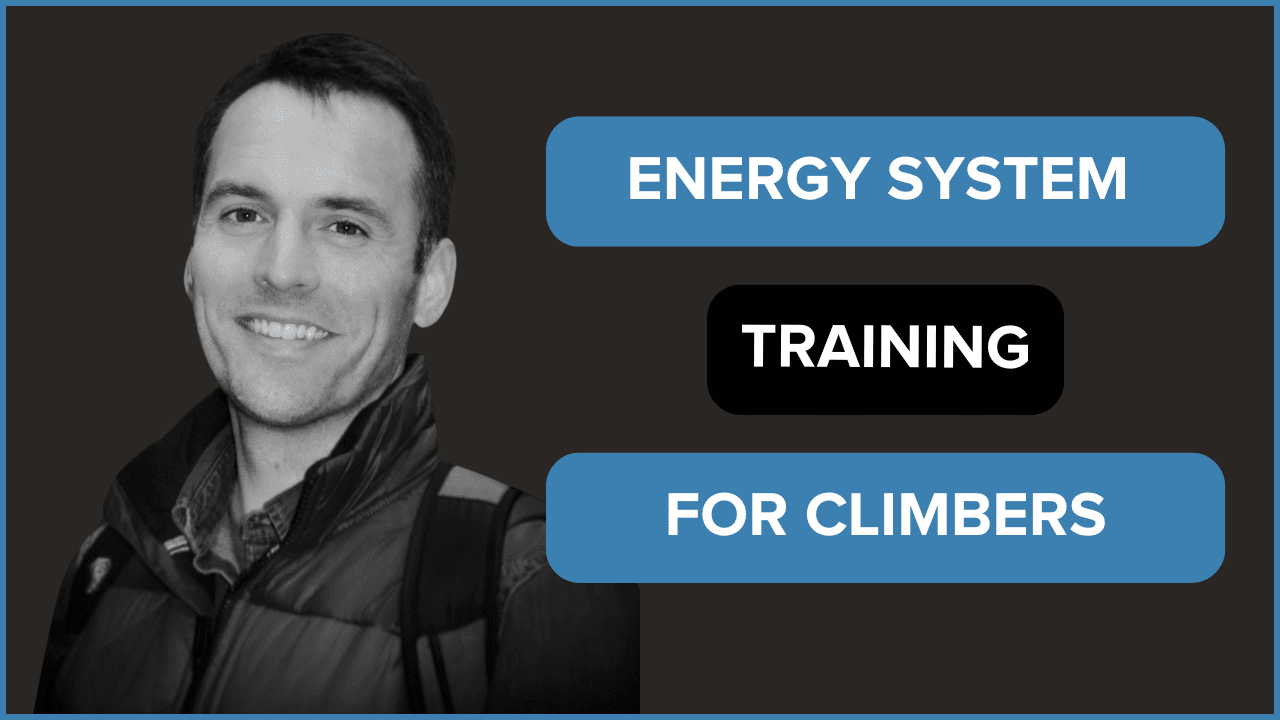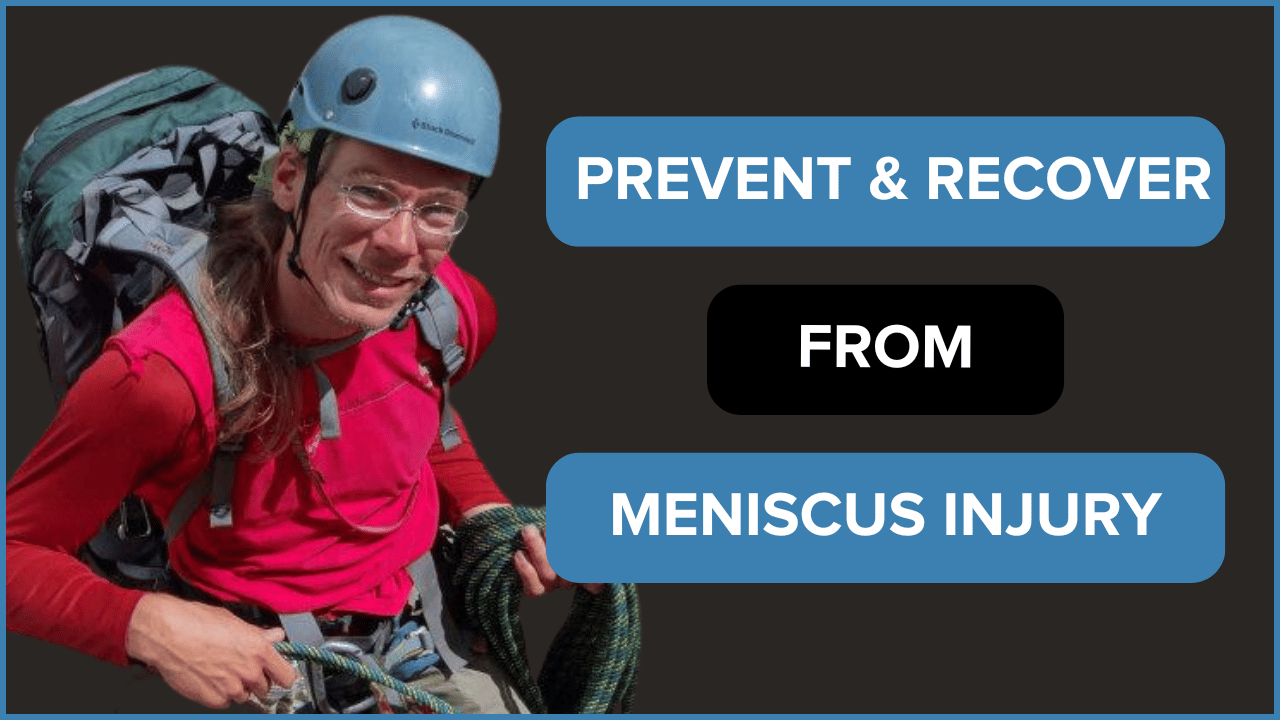S1, E5: Lower Your Risk For Climbing Injury – Eric Hörst
Watch as The Climbing Doctor interviews Eric Hörst on all topics related to climbing and injuries. They go deep in to tips to reduce injuries, warm-up routines, shoulder stability training, posterior chain exercises, finger health and maintenance, wrist strength, and a few final thoughts on how to climb injury-free.
Listen on Apple Podcasts, Spotify, or wherever you listen to podcasts!
- 0:00 Start
- 5:49 General tips that help you lower injury risk
- 13:45 Describe your own personal climbing warm-up
- 29:13 Describe the importance of training the shoulders
- 35:15 Go-to Exercises for the shoulders
- 37:36 Developing the posterior chain
- 46:15 Wrist stability for the fingers
- 50:46 Final words and last thoughts
f you would like to listen to the entire interview with Eric Hörst, check out the podcast. If you want to watch the interview, click the YouTube link or any of the timestamps above. If you would like to read quick sample of the interview, check out the excerpt from the interview below.
So I’m here with Eric Horst. Thank you, Eric, for joining.
Yeah. Great to be with you, Jared.
So Eric with all the climbers listening and watching this, can you introduce yourself and, I know you’ve done a lot in climbing and if you can just give your background?
Yeah. Well, Jared, I’m an old man compared to you, you know? I’m in my fifties and I’ve been climbing for 44 years, so I started as a teenager in the seventies when, by the way, there weren’t many teenage climbers. So, I was kind of a unique thing back then. But I quickly, as an athlete of other sports, got interested in training for climbing and that was a topic that didn’t exist. There was no talk of training in the seventies and eighties, other than a few people like John Gill, the boulderer and maybe John Bachar from Yosemite, but there were no magazine articles and certainly no websites on training for climbing. And so I began down this long path. It’s turned into a lifelong journey of not only learning to climb and become a master climber, but also to become a coach that incorporates the latest research on topics and helps steer climbers in the right direction when it comes to training with as much evidence basis as possible.
And also a heavy dose of just real life experience that I’ve gathered over forty plus years. And so you know, I’ve written a lot of books; eight books. There’s a dozen international translations of my books that are out there. So that’s pretty cool, that I have this global reach. And to have that influence and to be able to mentor climbers around the world, that’s a pretty cool thing. And you know, I have a climbing family; my wife climbs, my kids grew up climbing. They climb way harder than me. Now they’re both, you know, 5.14 plus climbers on their way to 5.15. So I can belay that grade, but I can’t climb that grade. And we enjoy as a family climbing and, as my kids move on to adulthood, my wife and I will continue traveling and climbing because we view climbing as a lifelong activity that enriches our life and adds balance to our life, amongst the many other things that we do.
And most recently I started a business PhysiVantage. It’s a performance nutrition company for climbers. I founded it in the fall of 2018 and we’ve grown quite rapidly in our first couple of years. And so that’s something that’s keeping me on my toes, in terms of being a businessman in addition to a coach and a climber and a dad and you know, so a lot of balls in the air, but that’s kind of how I like to live life is staying busy and staying engaged.
Yeah, definitely. And you have so much content and so much and all this content is research based. It’s very laid out step by step. That’s something I’ve always appreciated about the things that you put out.
Yeah. It’s now because of my age and my long time involved in this it’s multi-generational in terms of, like, dads can hand the book down to the, to the son. Of course, the contents have changed a lot and my first book that I wrote, which was called flash training in 1995, I believe; when I look at it today, it’s so grossly outdated that I cringe with the thought that anybody’s still looking at that book. And even the book you held in your hand there is more than 15 years old.
And you have written the book “Training for Climbing.” Is there a new version out?
Yea, there’s now a third edition of that book out. And because there wasn’t climber research or climbing type research or climbing medicine didn’t exist 30 years ago or even 20 years ago, but now there’s quite a robust community developing. So yeah, each addition and each book is advancing the ball and there’s other coaches and authors out there doing the same thing. So that’s a good thing for people getting into climbing in 2021. There is a lot more evidence based information than there was when I got started in this. Decades ago, there was none; it was all anecdote. I think any coach is hopefully communicating the latest sports science when, when they do their coaching, but obviously you have to also weigh your experience, so there’s always going to be some anecdote involved.
Are there any just general tips or tricks that you have that you found work for you specifically when it comes to staying healthy, preventing injuries and climbing for a long time?
Yeah, well that, that’s a broad subject. We could talk a lot about that.
Could spend hours talking about it.
Yeah. Of, of course. And, you know, because climbing stresses the body in so many different ways, climbers tend to be enthusiastic people who tend to put a few too many goes in on a Boulder problem in a single day or a single session.
That’s a respectful way of saying it.
Yeah. Or a few too many goes on their, or in my case, sport climbing project. And that’s of course the pathway to overuse injury. You know, runners, people who buy a new pair of running shoes and get into running and ramp up their mileage too fast, get shin splints or some other overuse injury oftentimes. And so for climbers, the overuse injuries commonly in the fingers or elbows and shoulders. I try to communicate that to beginning climbers, to hopefully avoid some of the pitfalls that my generation and that countless climbers encounter. I’ve had my share of injury over the years. And you can imagine in 40 years of climbing, I had a knee scoped in the nineties, I’ve had a couple of bouts of minor medial epicondylitis.
So pain on the inside of the elbow?
That’s right. You know, kind of like a tendonosis type thing that can drag on for months of failed healing until you finally do the right thing to get through it. I have had some shoulder issues. Nothing severe, but climbing is hard on the shoulders. My worst injury actually was a hernia, which I believe was my deadlifting of heavy freeways that probably was the trigger, not climbing, but that actually required a surgical repair. So I guess if you climb long enough, you’re not going to escape getting some type of ache or pain or a tweak or pull. But I think with good information and with discipline and by kind of resisting that climber way of always trying too hard. Hopefully most climbers can dodge the bullet. So, in any case, there’s many things that I’ve incorporated over the years to help lower injury risk. Should I go over some of those?
Yeah, just go for it!
The most obvious thing is to do some appropriate warmup just to get synovial fluid moving in the fingers and then the arms and shoulders. What I talk about is mild stretching. You don’t want to overstretch, but doing some mild stretching and actually more of a dynamic warmup is what I’ve, incorporated and endorsed in recent years. You know, things that involve movement as opposed to the old school static stretching; kind of getting away from that and becoming more active and doing easier climbing as a method of warming up for harder climbing. A big mistake of young, enthusiastic climbers, and that was once me was just showing up at the cliff or the boulder and getting right on the project and the warmup didn’t exist.
And of course that is not a prudent way to go about things. And then, being more aware of the potential for muscle imbalances. Climbing is for the most part, all about pulling. So, starting to incorporate some exercises that address the pushing movements, stretches that address common, tight spots or areas that lack mobility like in the shoulders. These are things that I didn’t know about; wasn’t really aware of 30 years ago. But today myself and most coaches and, sports medicine folks like yourself are all over that. You know, communicating that type of information. And again, I keep circling back to it, but climbers tend to be gluttons for punishment, and you have to know when to say when. Whether it’s in something basic, like hang board training or bouldering, or whether it’s being out at the crag doing burns on your project.
It’s often that last burn of the day where you’re fatigued, you’re getting sloppy, you can’t maintain a good posture on the moves and then you tweak a shoulder or tweak a pulley. And it seems that as you get fatigued late in the day or late in a workout, that’s when these things can happen, or maybe a motion that is the straw that breaks the camel’s back, so to speak. So why not just call it quits a little earlier? Or what I tell climbers to do is do another mental rep on the route where you visualize yourself.
You know, from an associated state. Close your eyes and not just rehearse the moves, but do the moves in your mind and try to create some of the kinesthetics. You know, some of the feel of the moves and that’s a real master skill for climbers is when you can learn to visualize not just the hold sequence, but the body position and the feel of the body positions: that’s visualization on steroids.
So why not do that? You know, at the end of the day, instead of doing another burn on the route, you’re not going send it. You’re tired, you’re weak, you’re not sharp mentally. But you can get injured if you take that last go on the route. So why not just make that last go a mental rep? And so that’s, that’s something I coach on.
So you are saying to make sure that we don’t exceed our capacity, we do something mentally, and get those neurons firing without the muscles and tendons overworking.
You bet. And you know, the whole thing about capacity: every climber is different in what their capacity is in terms of how many years they’ve been climbing and what their training history is, and their past sports history, and even genetics and age, and their diet. I mean, there’s a lot of things that influence how you hold up over the course of a workout or a long day of climbing. And just because your partner has another go or two left in them, doesn’t mean that you automatically do. And over time, you know, with a lot of climbing and appropriate training, the climber will gain capacity and be able to do those longer days.
So with what you’re saying, it really sounds like this consistency is key. And people may have different warmups, climbers may have a warmup different than a specific template, but knowing their body and always checking in and knowing that set level every time, and then really being able to adjust their training based on that seems so important.
That’s right. And a beginner has no basis for that. You know, this is kind of a skill that’s developed over time and it’s really a self-awareness. But to really do it right, I mean, we have in our gym all of us and all the people I coach, I encourage to keep written records. I mean, I love all the electronic options and training apps and things like that out there, but there’s something about having a written record of your workouts and being able to page back weeks or months and see what you were doing. And you can get some causal connections on things like if you got injured or if you, on the other end of the spectrum, had a PR day of climbing, you can say: “what was I doing in the weeks leading up to this PR day?”
And if you keep really detailed workout notes and, we put all of our warmups that auto regulation, where we figure out where we’re at on any given day, we write that down and record that. So we know where we’re at. And I think that data is really, really valuable. And so that’s what I encourage. The fact is most climbers end up being self-coached. They don’t have a coach over them, like an Olympic athlete has, or a college level athlete has. You know, most climbers are coaching themselves. And so you have to play both roles: climber and coach, and I think being able to collect that data and then access it is important, rather than just it being something that’s purely intuitive which, that’s better than nothing.
If you’re at least thinking about how you feel and how you might adjust your training for the day or your climbing for the day based on how you feel. That’s pretty basic and easy to do, I guess, but I’m talking about taking it to another level by actually doing the same warmup every day and, taking notes, and even if you really want make the most of it, even recording nutritionally you know? Because that’s a big part of recovery; how much protein are you consuming? How many calories are you consuming? And if you restrict too much in those areas, it can have adverse effect in your recovery and also contributes to injury potentially. And so there’s a lot of facets to proper training for climbing.
Where can people find you?
You can find me at the below places
Website: https://trainingforclimbing.com/
Instagram: @training4climbing
- Disclaimer – The content here is designed for information & education purposes only and the content is not intended for medical advice.




